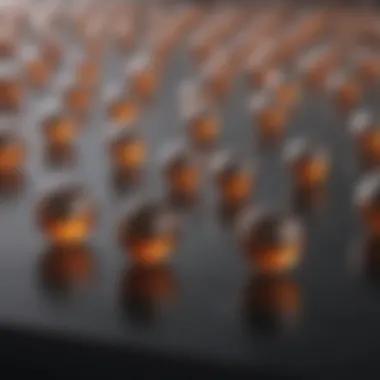InGaAs Diode: Structure, Principles, and Applications


Overview of Research Topic
Brief Background and Context
Indium Gallium Arsenide, commonly known as InGaAs, is a semiconductor material that has gained prominence in various technological applications. Its unique properties arise from the combination of Indium, Gallium, and Arsenide, which facilitates efficient photon absorption and electron transport. This quality renders InGaAs diodes particularly valuable in the realm of photodetection. Understanding the underlying structure and principles of InGaAs diodes is essential for both research and practical applications.
Historically, InGaAs diodes emerged as an advancement over traditional silicon-based counterparts. The ability to operate effectively in the infrared spectrum has driven their adoption across industries such as telecommunications, imaging, and environmental monitoring. As we navigate through the technological advancements, the role of InGaAs diodes becomes increasingly crucial.
Importance in Current Scientific Landscape
InGaAs diodes occupy a vital niche in modern technology. They are central to the development of high-speed data communication systems, where efficient signal detection is paramount. Their capability to sense lower wavelengths enhances performance in various sensors, paving the way for innovations in industries such as automotive, healthcare, and aerospace.
Moreover, the increasing demand for sustainable technologies has led to a surge in research focused on optimizing InGaAs devices. The potential for enhanced efficiency in energy applications, such as solar cells, showcases the relevance of InGaAs beyond traditional uses.
InGaAs diodes facilitate breakthroughs in signal detection and energy conversion, making them a focal point in technology development.
Methodology
Research Design and Approach
A thorough examination of InGaAs diodes incorporates both theoretical and experimental methodologies. A comprehensive literature review serves as a foundation, ensuring a firm understanding of existing research. This allows for the identification of gaps and emerging trends within the field.
In addition, experiments engaging in the fabrication and testing of InGaAs diodes provide practical insights. Such experiments include varying composition ratios of Indium and Gallium to assess how these changes affect overall performance.
Data Collection Techniques
Collecting data on the performance metrics of InGaAs diodes is essential in drawing meaningful conclusions. Techniques employed include:
- Photoluminescence measurements to assess material quality
- IV characterization to evaluate electrical properties
- Spectroscopy analysis to study response in different wavelength ranges
Each of these methods contributes to a holistic understanding of InGaAs diodes, bridging theoretical knowledge with experimental outcomes.
Prelims to InGaAs Diodes
InGaAs diodes are crucial components in various technological applications. Their significance stems from unique material properties and operational capabilities that have sparked advances in multiple fields. This section serves to lay the groundwork for understanding InGaAs diodes, highlighting elements that drive their importance in contemporary technology. By examining their definition and historical development, readers will gain valuable insights into how these devices operate and where they are applied.
Defining InGaAs Diodes
InGaAs diodes, short for Indium Gallium Arsenide diodes, are semiconductor devices made from a compound of indium, gallium, and arsenic. This specific composition gives them unique electrical and optical properties, particularly relevant for detecting infrared light. Unlike traditional silicon-based diodes, InGaAs diodes are sensitive to a broader range of wavelengths, especially in the near-infrared spectrum. They are essential in applications where light detection is critical, such as fiber optic communications, spectroscopy, and various sensing technologies. The ability to capture and convert light into an electrical signal with high efficiency makes these diodes a preferred choice in many applications.
Historical Context and Development
The evolution of InGaAs diodes is rooted in the desire to improve the efficiency and capabilities of photodetection devices. The initial development of this semiconductor material began in the late 1960s. Researchers identified that combining indium and gallium with arsenic could create a material with desirable band gap properties. Over the years, significant developments in fabrication techniques allowed for enhanced performance and reliability of InGaAs diodes.
During the 1980s, the advancements in InGaAs technology coincided with the rise of fiber optic communication networks. The unique properties of InGaAs diodes paved the way for their extensive use in telecommunications, safety systems, and industrial monitoring. The ongoing research and development continue to refine these devices, increasing their efficiency and expanding their applications in the ever-evolving technological landscape.
"InGaAs diodes remain a cornerstone of modern photonic applications, driven by continuous innovations in materials science and engineering."
As we delve deeper into the material properties and operational fundamentals of InGaAs diodes, it becomes evident that their growing significance will impact future technology advancements.
Material Properties of InGaAs
The material properties of Indium Gallium Arsenide (InGaAs) diodes are critical for understanding their performance and applicability in various technologies. These properties directly influence the efficiency, sensitivity, and operational capabilities of the diodes. Knowing these characteristics helps designers and engineers select the right materials for specific applications, ensuring optimal results. Furthermore, the unique properties of InGaAs allow for advancements in fields like telecommunications and photonics. This section will explore the essential aspects of InGaAs's material properties through its crystal structure and band gap characteristics.


Crystal Structure and Composition
InGaAs is a semiconductor compound formed from indium, gallium, and arsenic. Its crystal structure typically exhibits a zinc-blende arrangement, similar to that of gallium arsenide. This cubic crystal structure contributes to its electronic and optical properties. The composition can vary, specifically the ratio of indium to gallium, enabling custom tuning of the diode's electrical and thermal characteristics.
The composition of InGaAs is paramount. The varying ratio of indium and gallium allows for specific adjustments in the band gap, which is crucial for determining the wavelengths at which the diode operates efficiently. For example, a higher indium content in the ratio leads to a narrower band gap, enhancing infrared detection capabilities.
The versatility in composition means InGaAs can be engineered for diverse applications, from high-speed communications to sensitive infrared detectors.
In addition, the lattice matching to other semiconductor materials, such as indium phosphide, allows for the production of high-quality heterostructures. This is crucial for creating efficient devices that combine different semiconductor materials to improve overall performance and functionality.
Band Gap Characteristics
The band gap of InGaAs is a fundamental property influencing its operation. InGaAs has a direct band gap that ranges from about 0.75 eV to 1.70 eV, depending on the indium content. This range makes InGaAs particularly valuable for detecting infrared light. The ability to tune the band gap effortlessly enables flexibility in designing devices for different wavelengths, which is a significant advantage.
In practical terms, the band gap dictates the energy levels that electrons can occupy, affecting their movement and response to external light. When light is absorbed, electrons can move from the valence band to the conduction band, creating electron-hole pairs. The efficiency of this process is paramount in applications like photodetectors, where the aim is to maximize conversion of incident light into electrical signals.
InGaAs diodes therefore align well with solid-state applications, providing high responsiveness in a compact form factor. As material researchers continue to investigate the potential of InGaAs, they also look into how altering the band gap could yield even more robust devices for future technologies.
Operational Fundamentals
InGaAs diodes play a crucial role in various technologies, primarily due to their unique operational fundamentals. These diodes function effectively in a broad range of wavelengths, making them exceptionally suitable for applications in telecommunications, imaging systems, and sensing technologies.
Understanding their operational fundamentals allows for maximizing their potential in practical applications. The principles that govern the operation of these diodes influence their efficiency, size, and the types of signals they can detect. Moreover, insights into their operational characteristics lead to improvements in design and integration into different systems.
Principles of Operation
The operation of InGaAs diodes hinges on their semiconductor properties. Created from Indium, Gallium, and Arsenide, these compounds form a direct band gap material, which is pivotal for their function.
When InGaAs diodes are exposed to incident photons, several phenomena occur:
- Absorption: Photons with energy equal to or greater than the band gap energy of InGaAs are absorbed, generating electron-hole pairs. This process is key in photodiodes where light detection occurs.
- Charge Carrier Movement: Upon absorption, the created electron moves towards the conduction band while the hole moves towards the valence band, enabling electrical flow.
- Current Generation: The movement of these charge carriers generates a current, which can be measured. This current is proportional to the intensity of the incoming light, allowing for precise measurement in photodetection applications.
In summary, the principles of operation for InGaAs diodes center around the interaction of light with semiconductor materials, resulting in detectable electrical signals.
Key Electrical Characteristics
The electrical characteristics of InGaAs diodes define their performance and suitability for specific applications. Here are the main parameters that are of importance:
- Dark Current: This is the current that flows through the diode in the absence of light. Lower dark current values indicate higher sensitivity and better performance.
- Responsivity: This measure indicates how effectively a diode converts incident light into electrical current. Higher responsivity values are preferred in detection applications.
- Quantum Efficiency: This metric reveals the efficiency of converting incoming photons into charge carriers. It is calculated as the number of charge carriers generated per incident photon. A higher quantum efficiency shows better performance in photodiodes.
- Wavelength Sensitivity: InGaAs diodes have excellent sensitivity in the near-infrared range, typically from 900 nm to 1700 nm. This range expands their usability in various applications like telecommunications and spectroscopy.
Understanding these characteristics is essential during the design process of systems employing InGaAs diodes. Optimizing these parameters can lead to significant improvements in performance across applications.
"The operational efficiency of InGaAs diodes significantly impacts advancements in photonics and telecommunications."
Types of InGaAs Diodes
The classification of InGaAs diodes is essential to understanding their functionality and applications in various fields. Each type of diode operates based on the unique material properties and design, enabling a range of uses from telecommunications to sensing technologies. A comprehensive understanding of different types of InGaAs diodes allows researchers and professionals to select the most suitable diode for specific applications, thereby optimizing performance and efficiency.
Photodiodes
Photodiodes are semiconductor devices that convert light into electrical current. The InGaAs photodiodes are particularly known for their sensitivity in the near-infrared spectrum, covering a range from 900 nm to 1700 nm. This capability allows them to effectively detect signals in fiber optic communications, making them pivotal in modern telecommunication systems.
Benefits of InGaAs Photodiodes:
- High Responsivity: InGaAs photodiodes exhibit high quantum efficiency, translating to greater sensitivity to light.
- Wide Spectral Response: Their ability to operate over a broader wavelength range enhances their versatility in various applications.
- Low Noise Characteristics: InGaAs technology reduces electronic noise, which is critical in precision measurements and detection tasks.


These advantages make InGaAs photodiodes prevalent in several areas, such as spectroscopy, imaging systems, and optical sensing applications. Their development has also focused on improving speed performance, catering to the demands of high-speed data communication.
Laser Diodes
InGaAs laser diodes are a crucial advancement in laser technology, offering high-efficiency solutions for various applications. Used primarily in telecommunications and sensing, they operate effectively at wavelengths that are critical for fiber-optic communication. These diodes typically emit light in the 980 nm to 1550 nm range, optimizing transmission efficiency in optical fibers.
Key Characteristics of InGaAs Laser Diodes:
- High Power Output: They provide significant output power with compact designs, helpful for long-distance communication.
- Temperature Stability: InGaAs laser diodes present stable performance across different temperature ranges, confirming their reliability for various applications.
- Compatibility with Fiber Optics: Their wavelength compatibility aligns them perfectly with commonly used optical fibers, facilitating efficient signal transmission.
The reliability and efficiency of InGaAs laser diodes make them a preferred choice for applications in laser-based systems, especially in telecommunications, where maintaining signal integrity over long distances is essential.
Heterojunctions
Heterojunctions play a pivotal role in the operation of InGaAs diodes. They are formed by the union of different semiconductor materials, typically, in this case, combining InGaAs with other materials like Indium Phosphide (InP) or Gallium Arsenide (GaAs). This integration allows for tailored electronic and optical properties that enhance the performance of the devices.
Advantages of InGaAs Heterojunctions:
- Improved Efficiency: The presence of multiple semiconductor materials leads to enhancements in carrier mobility and reduced recombination rates, optimizing efficiency.
- Adjustable Band Gap: By varying the materials in the heterojunction, manufacturers can customize the band gap, allowing for the design of devices with specific wavelength characteristics.
- Enhanced Performance at High Frequencies: Heterojunction diodes generally exhibit better performance at higher frequencies, making them suitable for applications necessitating rapid modulation.
Overall, InGaAs heterojunctions significantly broaden the scope of diodes in the field of optoelectronics, providing a platform for innovation in areas such as high-speed data communication and advanced sensing technologies.
"Understanding the types of InGaAs diodes is vital for anyone involved in technology relying on optoelectronic systems. Each type offers unique properties suited for specific high-tech applications."
Applications of InGaAs Diodes
InGaAs diodes have gained significant traction throughout various sectors owing to their unique properties. These properties make them versatile components suitable for different technological applications. Understanding these applications is crucial for anyone involved in the fields of engineering, research, and technology development. The integration of InGaAs diodes leads to enhanced operational efficiencies and improved performance in their respective applications.
Telecommunications
In the telecommunications sector, InGaAs diodes play a vital role, especially in fiber optic communications. They are employed in optical receivers due to their sensitivity to near-infrared light. This capability enables faster data transmission over long distances, which is crucial for maintaining high bandwidth in telecommunication networks. The efficiency of InGaAs photodiodes translates to lower noise levels, allowing for clearer signal detection. Moreover, their response time is remarkably fast, facilitating higher data rates which are essential for modern communication systems.
Telecommunications applications include:
- Optical Fiber Transmission: Utilizing InGaAs diodes enhances the transmission quality and enables long-distance communication.
- Wavelength Division Multiplexing: These diodes allow for multiple data streams to be sent simultaneously over a single fiber, maximizing bandwidth utilization.
- Optical Network Units: InGaAs diodes enhance the performance and reliability of devices in network configurations.
Spectroscopy and Sensing
InGaAs diodes are critical in spectroscopy and sensing technologies. Their ability to detect a wide range of wavelengths makes them invaluable for measuring light across various spectra. This capability is particularly significant in applications such as environmental monitoring, pharmaceutical analysis, and even food safety inspections. By measuring the reflected or transmitted light, InGaAs diodes provide valuable information on material properties and compositions.
In applications of spectroscopy and sensing, notable uses include:
- NIR Spectroscopy: InGaAs diodes enable the study of substances that are opaque or have weak absorption in visible light. This is important for analyzing organic compounds.
- Gas Sensing: Their precision in detecting gas concentrations contributes to safety and environmental monitoring.
- Chemical Analysis: Industries rely on InGaAs diodes for quality control and material verification.
Imaging Systems
InGaAs diodes are also prominent in imaging systems, particularly in applications requiring high sensitivity in low light conditions. Their performance in charge-coupled device (CCD) or complementary metal-oxide-semiconductor (CMOS) technologies allows for the production of detailed images across various spectrum ranges. This capability proves essential in fields such as night vision imaging and thermal imaging systems, where visibility is often compromised.
Key areas in imaging systems include:
- Night Vision Equipment: InGaAs diodes enhance visibility and object detection in dark environments, making them crucial for military and surveillance applications.
- Thermal Imaging: These diodes provide accurate thermal profiles, useful in medical diagnostics and predictive maintenance for machinery.
- Industrial Inspection: InGaAs technology facilitates non-destructive testing in manufacturing processes, ensuring product quality.
In summary, InGaAs diodes are rapidly becoming integral to modern technological advancements, offering tools for enhanced measurements and communications across diverse applications.
Advancements in InGaAs Technology


Technological advancements in InGaAs diodes have been significant and they continue to evolve. These advancements are critical in driving innovation in various fields, particularly in telecommunications and sensing applications. The progress made in this area not only enhances performance but also opens new possibilities for integration and functionality. Addressing challenges related to efficiency and reliability in different environments is essential in improving InGaAs devices.
Recent Innovations
In recent years, several innovations have emerged in InGaAs technology. One key development is the improvement in manufacturing techniques. Advances in growth methods, such as metal-organic chemical vapor deposition (MOCVD), have led to better control over crystal quality and composition. This results in superior diode performance and reduced defects, enhancing overall efficiency.
Another notable innovation is related to detector sensitivity across a broader range of wavelengths. Enhanced InGaAs photodiodes now provide increased responsivity, making them suitable for applications in telecommunications and spectroscopy. Furthermore, these improved detectors exhibit faster response times, enabling them to be used in high-speed communication systems.
In addition, integration with complementary metal-oxide-semiconductor (CMOS) technology is increasingly common. This integration simplifies system architecture and reduces costs, making InGaAs diodes more accessible for widespread use. Modern designs leverage the compatibility of InGaAs with existing electronic components, which enhances functionality and usability.
Future Trends
Looking ahead, several trends are expected to shape the future of InGaAs technology. One significant trend is the ongoing push towards miniaturization and integration. As devices become more compact, the demand for smaller, more efficient InGaAs components will grow. This will drive research into new materials and structures that offer improved performance in smaller packages.
Moreover, there is an increasing focus on enhancing thermal and environmental stability. Future InGaAs diodes will likely be designed to withstand extreme conditions while maintaining performance. This aspect is vital for applications in harsh environments, such as aerospace and industrial monitoring.
Another compelling trend is the expansion into newer application areas. For instance, the growing field of quantum computing may see the incorporation of InGaAs diodes for specific functionalities. Increased interest in photonic circuits and optoelectronic devices also suggests applications that are yet to be fully explored.
Challenges in InGaAs Applications
InGaAs diodes possess distinct advantages that enable their utilization in a range of high-tech applications. However, significant challenges still exist when it comes to their implementation. Understanding these challenges is crucial for researchers, engineers, and industries looking to harness the potential of InGaAs technology. A closer look at the material limitations and technical constraints helps to highlight the intricacies involved in optimizing InGaAs diode performance in practical situations.
Material Limitations
The effectiveness of InGaAs diodes is often hindered by certain material limitations inherent in their composition. InGaAs is a ternary semiconductor composed of indium, gallium, and arsenic. While this composition endows the material with favorable properties like high electron mobility and a suitable bandgap for infrared detection, it brings some unavoidable issues.
One challenge lies in the quality of the crystal lattice. Defects within the lattice structure can lead to increased recombination of charge carriers, which diminishes efficiency. Furthermore, tuning the bandgap to suit specific applications is complex. A precise ratio of indium and gallium must be maintained to achieve desired properties, since variations may affect the diode's performance. Additionally, the handling and processing of InGaAs can be tricky, as its vulnerability to oxidation necessitates careful fabrication environments.
Technical Constraints
Beyond material limitations, technical constraints in designing and deploying InGaAs diodes also play a pivotal role. These constraints encompass various factors including thermal management, integration with existing systems, and scalability in manufacturing.
Thermal management is critical because InGaAs diodes often operate in environments where heat generation can impact their performance. Effective cooling solutions must be implemented to ensure sustained operational efficacy. A lack of proper thermal management can lead to degradation and reduced lifespan of the devices.
Another technical challenge revolves around interfacing InGaAs diodes with other components within a system. Compatibility with established technologies is essential for seamless integration. Engineers must consider the differences in material properties and electrical characteristics when designing circuits and devices that incorporate InGaAs diodes.
Scalability poses its own unique set of challenges. As demand for InGaAs applications increases, manufacturers must find ways to produce high-quality diodes consistently and cost-effectively. Furthermore, the synthesis of uniform materials while minimizing defects is crucial for maintaining performance standards across larger production runs.
In summary, addressing the material limitations and technical constraints of InGaAs diodes is imperative for their successful application in modern technologies.
Navigating these challenges is essential for researchers and engineers aimed at optimizing InGaAs diode utilization, ultimately leading to innovations in photonics and related fields.
Finale and Implications
The exploration of InGaAs diodes reveals several crucial aspects that underscore their importance in modern technology. While the material properties and operational fundamentals have been discussed in previous sections, the concluding section aims to synthesize these elements, emphasizing their implications for various fields. InGaAs diodes have emerged as a cornerstone in photodetection, telecommunications, and sensing technologies, capitalizing on their superior efficiency and responsiveness in the infrared spectrum.
Summary of Findings
This article sheds light on the unique characteristics of InGaAs diodes. Key findings include:
- Material Properties: InGaAs's composition allows for tailored band gap characteristics. This directly enhances the diodes' performance in specific wavelength ranges, particularly for applications in telecommunications and sensing.
- Operational Efficiency: Their principles of operation illustrate how InGaAs diodes convert light into electrical signals effectively. This efficiency is critical in applications requiring high-speed data transmission and accurate measurements.
- Diverse Applications: InGaAs diodes demonstrate versatility across numerous applications. From fiber optic communications to advanced imaging systems and spectroscopy, their role is pivotal in pushing technological boundaries.
"The versatility and efficiency of InGaAs diodes not only meet current technological demands but also pave the way for future advancements, making them an integral element in the success of innovative applications."
Significance for Future Research
Looking ahead, the significance of InGaAs diodes for future research cannot be overstated. Continued advancements are essential for several reasons:
- Material Innovation: To enhance the performance and bandwidth of InGaAs diodes, further investigation into new materials and compound semiconductors may yield improved versions with better temperature stability and efficiency.
- Integration with Emerging Technologies: As the fields of quantum computing and artificial intelligence evolve, integrating InGaAs diodes into new devices could facilitate breakthroughs in performance.
- Enhanced Application Potential: Research focused on niche applications such as automotive sensing and biomedical diagnostics can exploit the unique advantages of InGaAs technology. This alignment can drive product development that directly addresses specific market needs.
In culmination, understanding the implications and future directions of InGaAs diode research is vital for leveraging their functionalities effectively in the fast-evolving technological landscape.



